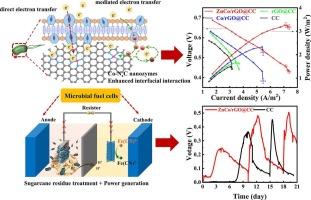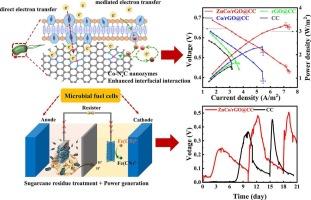利用掺杂 Co-Nx 的碳纳米管/石墨烯仿生阳极复合材料提升微生物燃料电池性能
IF 6.9
2区 材料科学
Q2 CHEMISTRY, PHYSICAL
引用次数: 0
摘要
提高微生物燃料电池(mfc)的性能以实现可持续能源生产需要创新的阳极设计,以促进高效的细胞外电子转移(EET)。本研究提出了一种仿生阳极制造方法,开发了一种受c型细胞色素EET机制启发的分层Co-Nx掺杂碳纳米管/还原氧化石墨烯(ZnCo/rGO@CC)复合材料。该复合材料利用Co-Nx活性位点的协同效应,模拟血红素基团,以及三维多孔结构来促进细菌定植和电子转移。采用ZnCo/rGO@CC阳极的mfc的最大功率密度为3.27 W/m2,启动时间为1.68 天,显著优于传统碳布阳极(分别为1.49 W/m2和2.50 天)。MFC系统成功地使用甘蔗渣作为燃料源,其功率密度为1.58 W/m2,进一步证明了其可持续废物价值化的潜力。电化学分析和微生物群落表征证实了EET动力学的增强,Geobacter的选择性富集(79.73 %),以及ZnCo/rGO@CC阳极上强大的生物膜形成。这种仿生阳极设计,结合甘蔗渣的利用,为开发可持续和高效的清洁能源生产生物电化学系统提供了一种有前途的策略。本文章由计算机程序翻译,如有差异,请以英文原文为准。


Boosting microbial fuel cell performance with Co-Nx doped carbon nanotubes/graphene biomimetic anode composites
Enhancing the performance of microbial fuel cells (MFCs) for sustainable energy generation requires innovative anode designs that facilitate efficient extracellular electron transfer (EET). This study presents a biomimetic approach to anode fabrication, developing a hierarchical Co-Nx doped carbon nanotube/reduced graphene oxide (ZnCo/rGO@CC) composite inspired by the EET mechanisms of c-type cytochromes. The composite leverages the synergistic effects of Co-Nx active sites, mimicking heme groups, and a three-dimensional porous structure to promote bacterial colonization and electron transfer. MFCs equipped with the ZnCo/rGO@CC anode achieved a maximum power density of 3.27 W/m2 and a startup time of 1.68 days, significantly outperforming traditional carbon cloth anodes (1.49 W/m2 and 2.50 days, respectively). Further demonstrating its potential for sustainable waste valorization, the MFC system was successfully operated using sugarcane bagasse as a fuel source, exhibiting a power density of 1.58 W/m2. Electrochemical analyses and microbial community characterization confirmed enhanced EET kinetics, selective enrichment of Geobacter (79.73 %), and robust biofilm formation on the ZnCo/rGO@CC anode. This biomimetic anode design, coupled with the utilization of sugarcane bagasse, offers a promising strategy for developing sustainable and efficient bioelectrochemical systems for cleaner energy production.
求助全文
通过发布文献求助,成功后即可免费获取论文全文。
去求助
来源期刊

Applied Surface Science
工程技术-材料科学:膜
CiteScore
12.50
自引率
7.50%
发文量
3393
审稿时长
67 days
期刊介绍:
Applied Surface Science covers topics contributing to a better understanding of surfaces, interfaces, nanostructures and their applications. The journal is concerned with scientific research on the atomic and molecular level of material properties determined with specific surface analytical techniques and/or computational methods, as well as the processing of such structures.
 求助内容:
求助内容: 应助结果提醒方式:
应助结果提醒方式:


